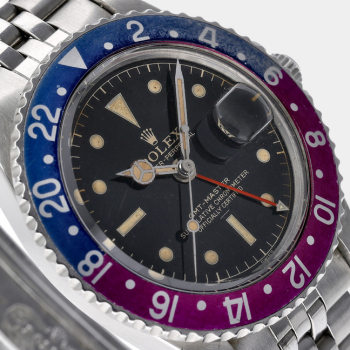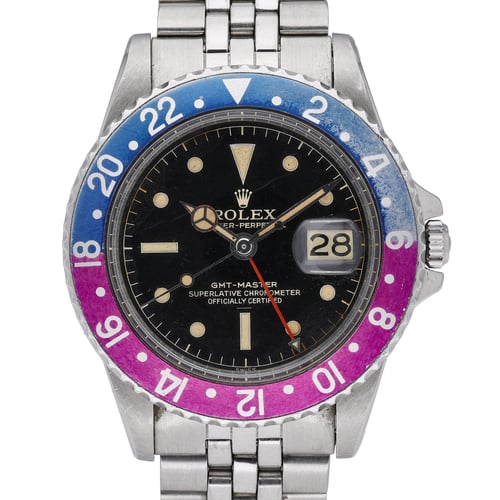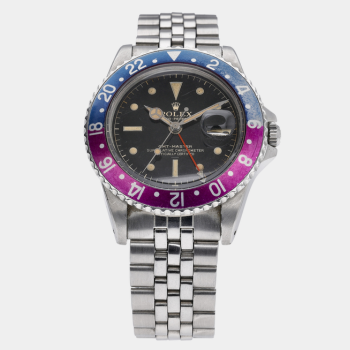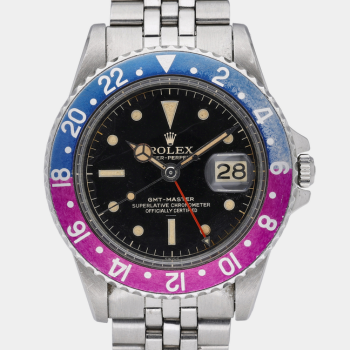Among vintage Rolex collectors, few references inspire the same level of passion as the GMT-Master 1675. Produced between 1959 and 1980, it is one of the longest-running references in the brand’s history. Yet, within those two decades, Rolex introduced a variety of subtle but crucial changes to the model’s case, dial, bezel, and typography. As a result, certain iterations of the 1675 are far more collectible than others.
Standing out among these is a very special configuration: the gilt dial 1675 with the Long E inscription, pointed crown guards, and a fuchsia bezel insert. Each feature carries its own story, but together, they form one of the most coveted combinations in vintage Rolex.

The GMT-Master line was born from Rolex’s partnership with Pan Am Airways in the mid-1950s. The airline had begun operating long-haul intercontinental flights, and pilots needed a way to track multiple time zones while in the cockpit. Rolex responded with the GMT-Master ref. 6542 in 1954, featuring a 24-hour hand and a rotating bezel insert in red and blue bakelite.
While groundbreaking, the 6542 was fragile. Its bakelite bezel was prone to cracking, and the lack of crown guards left the winding crown exposed. By 1959, Rolex introduced the ref. 1675 to address these issues. It featured a more robust aluminum bezel insert and a larger case fitted with protective crown guards.
The 1675 quickly became the watch of professional pilots and world travelers alike. Over the following decades, it appeared on the wrists of Pan Am captains, NASA astronauts, and even cultural icons such as Marlon Brando and Fidel Castro.
Early 1675s were fitted with gilt dials, produced from 1959 until around 1966. Unlike later matte dials, these featured a glossy black lacquer surface with text and minute markers etched away, exposing the brass plate beneath. The result is lettering that appears gold in tone - hence the term “gilt.”
Beyond their rarity, gilt dials possess a unique visual depth. Light reflects across the lacquer, giving the dial a glossy, liquid-like effect that feels warmer and richer than the matte dials that followed. Many gilt dials also feature a “chapter ring,” a circular border connecting the minute markers, which collectors view as an additional marker of early production.
For Rolex purists, gilt GMT-Masters are some of the most beautiful sports watches ever produced. Their dials not only mark an earlier era of watchmaking but also embody the artisanal character that Rolex has since perfected into modern-day precision.


One detail that separates certain gilt dials from others is the typography of the word “ROLEX.” On so-called “Long E” dials, the center bar of the “E” is extended, making it exactly the same length as the top and bottom bars. This subtle typographic quirk is highly sought after, as it reflects one of the dial printing variations unique to the 1960s.
Collectors prize these Long E dials because they help pinpoint originality and production period.
To the casual observer, it may seem like minutiae - but for vintage Rolex enthusiasts, it’s these microscopic details that carry significant weight in both scholarship and value.
The earliest 1675s were fitted with pointed crown guards, also known as “cornino” among Italian collectors (literally meaning “little horns”). Unlike the rounded crown guards of later production, these early guards are sharp and angular, giving the case a distinctly aggressive profile.
Pointed crown guards were produced only for a few short years, making them particularly rare. They were later phased out in favor of thicker, rounded crown guards that offered more durability.
Finding a gilt-dial 1675 with original pointed crown guards and correct proportions is exceedingly difficult today, as many examples have been polished or had their cases reworked over decades of use.


If the gilt dial is the soul of a vintage 1675, then the fuchsia bezel insert is its crown jewel. Originally produced in red and blue, these aluminum inserts have, over time, aged into extraordinary colors. On certain batches, the red dye naturally faded into a vibrant pinkish-magenta hue, creating what collectors now call the “fuchsia” insert.
Each faded insert is unique. Some lean toward deep magenta, while others take on lighter pink or even violet tones. The transformation was never intentional - it was a byproduct of the materials Rolex used in the 1960s. Yet today, these inserts command a significant premium, celebrated as one of the most charismatic examples of how vintage watches acquire character through age.
Against the glossy gilt dial and stainless steel case, the fuchsia bezel provides a burst of color that is both playful and exotic. It completely changes the personality of the watch, turning an already rare configuration into something truly striking.
When gilt dials, Long E typography, pointed crown guards, and fuchsia bezel inserts appear together on a single Rolex GMT-Master 1675, they represent the reference at its absolute peak. This combination blends artistry, rarity, and the natural charm of vintage aging, making these watches exceedingly rare and highly sought-after - often commanding six-figure sums at top auctions.
Beyond their value, these details tell a story of Rolex in the 1960s: a tool watch evolving into a cultural icon. The gilt, Long E, pointed crown guard, fuchsia 1675 embodies design innovation, pilot heritage, and the collector’s quest for originality. Owning one is not just about rarity - it’s about holding a piece of horological history that bridges functionality with enduring mythos.
If you have a particular used GMT-Master watch in mind, we’re more than happy to source the perfect pre-owned timepiece. As a leading retailer of luxury watches in England, we have the knowledge and resources to track down that special timepiece that you’ve been dreaming about.
Get in touch with one of our knowledgable staff to find your perfect Rolex vintage GMT today. Simply fill in the form below and one of our team will be delighted to help you.